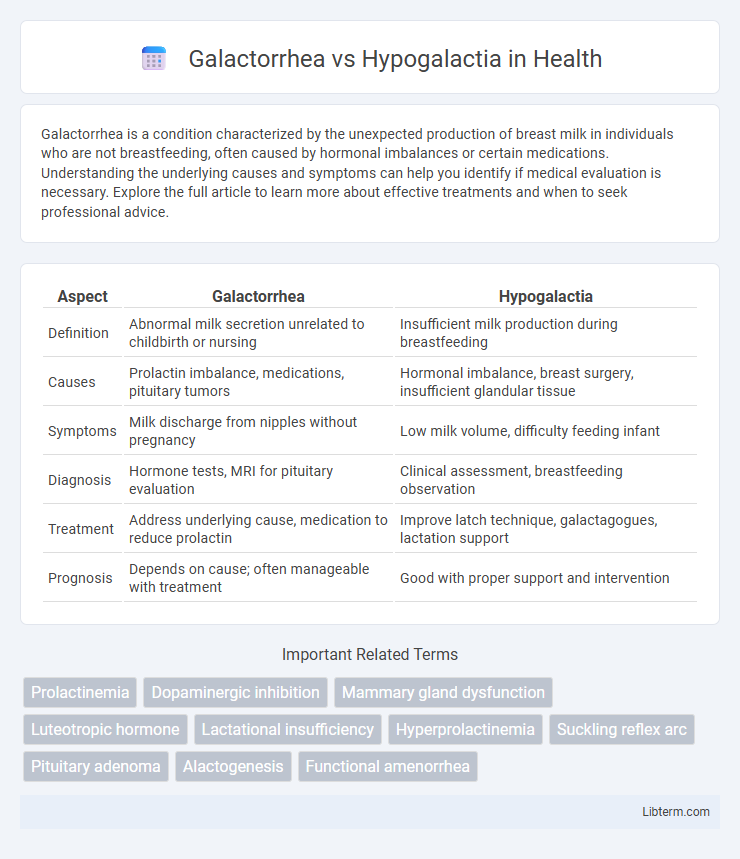Galactorrhea is a condition characterized by the unexpected production of breast milk in individuals who are not breastfeeding, often caused by hormonal imbalances or certain medications. Understanding the underlying causes and symptoms can help you identify if medical evaluation is necessary. Explore the full article to learn more about effective treatments and when to seek professional advice.
Table of Comparison
| Aspect | Galactorrhea | Hypogalactia |
|---|---|---|
| Definition | Abnormal milk secretion unrelated to childbirth or nursing | Insufficient milk production during breastfeeding |
| Causes | Prolactin imbalance, medications, pituitary tumors | Hormonal imbalance, breast surgery, insufficient glandular tissue |
| Symptoms | Milk discharge from nipples without pregnancy | Low milk volume, difficulty feeding infant |
| Diagnosis | Hormone tests, MRI for pituitary evaluation | Clinical assessment, breastfeeding observation |
| Treatment | Address underlying cause, medication to reduce prolactin | Improve latch technique, galactagogues, lactation support |
| Prognosis | Depends on cause; often manageable with treatment | Good with proper support and intervention |
Understanding Galactorrhea and Hypogalactia
Galactorrhea is characterized by the spontaneous flow of milk from the breast unrelated to childbirth or nursing, often caused by hormonal imbalances such as elevated prolactin levels. Hypogalactia refers to insufficient milk production during lactation, commonly resulting from inadequate glandular tissue or hormonal deficiencies. Differentiating between these conditions involves assessing prolactin concentrations and evaluating lactation sufficiency to guide appropriate clinical management.
Key Differences Between Galactorrhea and Hypogalactia
Galactorrhea is characterized by excessive or inappropriate milk production unrelated to childbirth or nursing, often caused by hormonal imbalances such as elevated prolactin levels. In contrast, hypogalactia refers to insufficient milk production during lactation, commonly due to factors like inadequate gland development or hormonal deficiencies. The key difference lies in galactorrhea's abnormal milk secretion versus hypogalactia's inadequate milk supply for breastfeeding.
Causes of Galactorrhea
Galactorrhea is primarily caused by hyperprolactinemia due to pituitary adenomas, hypothyroidism, or medications such as antipsychotics and antihypertensives, leading to inappropriate milk secretion. Other causes include chest wall stimulation, chronic kidney disease, and use of estrogen or dopamine antagonists. Hypogalactia, in contrast, often results from insufficient glandular tissue, poor latch during breastfeeding, or hormonal imbalances such as low prolactin levels.
Causes of Hypogalactia
Hypogalactia primarily results from insufficient milk production caused by factors such as hormonal imbalances (e.g., low prolactin levels), inadequate breastfeeding techniques, or breast tissue damage following surgery or infection. Other significant causes include maternal stress, malnutrition, and certain medications like dopamine antagonists or hormonal contraceptives that inhibit lactation. Addressing these underlying factors is essential for managing hypogalactia and improving lactation outcomes.
Common Symptoms and Clinical Presentation
Galactorrhea presents with spontaneous, non-puerperal milk secretion, often accompanied by amenorrhea and visual disturbances due to pituitary adenomas. Hypogalactia is characterized by insufficient milk production postpartum, leading to poor infant weight gain and feeding difficulties. Both conditions may involve hormonal imbalances, but galactorrhea typically involves hyperprolactinemia, whereas hypogalactia often relates to inadequate prolactin response or breast tissue insufficiency.
Diagnostic Approaches for Each Condition
Galactorrhea diagnosis involves measuring serum prolactin levels and performing pituitary imaging, such as MRI, to identify underlying causes like prolactinomas. Hypogalactia assessment requires evaluation of breastfeeding techniques, maternal hormone levels including oxytocin and prolactin, and ultrasound of breast tissue to detect insufficient milk production causes. Both conditions necessitate thorough history-taking and physical examination to differentiate physiological from pathological origins.
Treatment Strategies for Galactorrhea
Treatment strategies for galactorrhea primarily target the underlying causes, such as hyperprolactinemia or medication side effects, using dopamine agonists like bromocriptine or cabergoline to reduce prolactin levels effectively. Addressing thyroid dysfunction or discontinuing offending drugs can also resolve symptoms. In contrast, hypogalactia treatment focuses on enhancing milk production through lactation support, galactagogues, and optimizing breastfeeding techniques.
Management Options for Hypogalactia
Hypogalactia, characterized by insufficient milk production, is managed through interventions such as frequent breastfeeding or pumping to stimulate milk supply, ensuring adequate maternal hydration and nutrition, and addressing underlying conditions like hormonal imbalances. Galactagogues including domperidone or metoclopramide may be prescribed to increase prolactin levels and enhance lactation. Support from lactation consultants and counseling on proper breastfeeding techniques also play a crucial role in improving milk yield in hypogalactia cases.
Preventive Measures and Risk Reduction
Preventive measures for galactorrhea include regular monitoring of prolactin levels, avoiding medications that increase prolactin secretion such as antipsychotics and certain antidepressants, and managing underlying conditions like hypothyroidism. Hypogalactia risk reduction involves optimizing maternal nutrition with adequate caloric and protein intake, ensuring proper breastfeeding technique to stimulate milk production, and addressing hormonal imbalances such as low prolactin or oxytocin levels. Maintaining a healthy lifestyle with stress management and timely medical intervention for endocrine disorders supports prevention and effective management of both conditions.
When to Seek Medical Attention
Seek medical attention for galactorrhea if there is unexpected milk production unrelated to childbirth or breastfeeding, especially when accompanied by menstrual irregularities, headaches, or vision changes, as these may indicate underlying hormonal imbalances or pituitary disorders. For hypogalactia, consult a healthcare provider when milk supply remains insufficient despite frequent nursing or pumping, leading to poor infant weight gain or feeding difficulties, to identify possible causes like hormonal deficiencies or breast tissue issues. Early medical evaluation ensures timely diagnosis and appropriate management of both conditions to support maternal and infant health.
Galactorrhea Infographic

 libterm.com
libterm.com